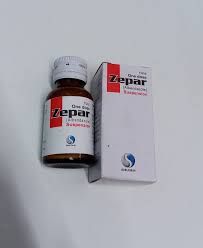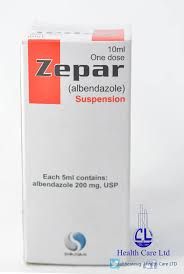Zepar Syrup is an oral suspension containing albendazole, an anthelmintic medication used to treat a variety of parasitic worm infections. This syrup formulation is particularly suitable for children or individuals who have difficulty swallowing tablets.
Key Features
- Active Ingredient: Each 5ml of Zepar Syrup typically contains 200 mg of albendazole.
- Packaging: Available in a 10ml bottle, making it easy to measure and administer.
Indications
Zepar Syrup is indicated for the treatment of:
- Intestinal Helminth Infections: Effective against:
- Roundworms (Ascaris)
- Hookworms (Ancylostoma, Necator)
- Whipworms (Trichuris)
- Pinworms (Enterobius)
- Tapeworms (Taenia)
- Tissue Infections: Such as:
- Neurocysticercosis (caused by the pork tapeworm)
- Cystic hydatid disease (caused by the dog tapeworm)
Mechanism of Action
Albendazole works by inhibiting the polymerization of tubulin, which disrupts the metabolism of the parasites. This leads to energy depletion and immobilization, ultimately resulting in the death of the worms.
Dosage and Administration
- Recommended Dosage: The typical dosage for adults and children over 2 years is usually 10ml (400 mg) taken as a single dose or as directed by a healthcare provider. For specific infections, dosing may vary.
- Administration Tips: Shake well before use. It is best taken with food to enhance absorption.
Side Effects
Common side effects may include:
- Nausea
- Vomiting
- Abdominal pain
- Headache
- Dizziness
Serious side effects requiring immediate medical attention include:
- Signs of severe allergic reactions (e.g., rash, swelling).
- Symptoms of liver dysfunction (e.g., jaundice).
Precautions
- Contraindications: Not recommended for individuals with known hypersensitivity to albendazole or any other components. Use with caution in patients with liver disease.
- Pregnancy and Breastfeeding: Consult a healthcare provider before use during pregnancy or breastfeeding.
- Drug Interactions: Inform your healthcare provider about any other medications being taken to avoid potential interactions.


